Home | Tours | Trip Reports | News | Team | Calendar | Links | Contact | Store | Mailing List
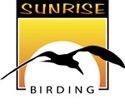
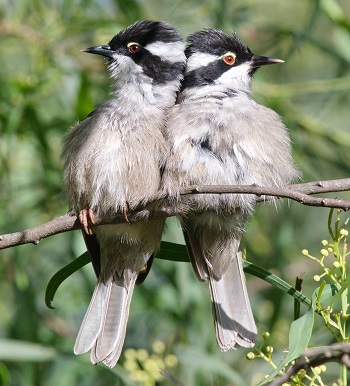 TASMANIA!
TASMANIA!November 1 - 10, 2026
Contact
gina@sunrisebirding.com to reserve
your space!
Trip Cost & Travel Planning> Registration Form>
Tour
Registration, Terms,
Cancellation Policies>
COMBINE THIS TOUR WITH
SOUTHEAST AUSTRALIA,
October 22 - November 1, 2026
INFO & RESERVATIONS>
Tasmania is known for its rugged terrain, diverse ecosystems and spectacular scenery. It has 18 national parks, including Cradle Mountain as well as ancient forests, lake-dotted mountain ranges, and pristine marine playgrounds. Our comprehensive tour of Tasmania offers the chance to see all of Tasmania’s 12 endemic birds plus iconic animals including Platypus, Forester Kangaroo, Common Wombat, Spotted-tail Quoll, Tasmanian Padmelon, Bennett’s Wallaby, Echidna and Tasmanian Devil.
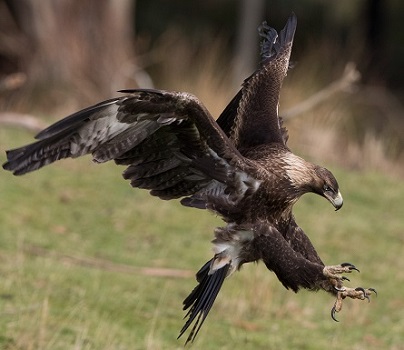
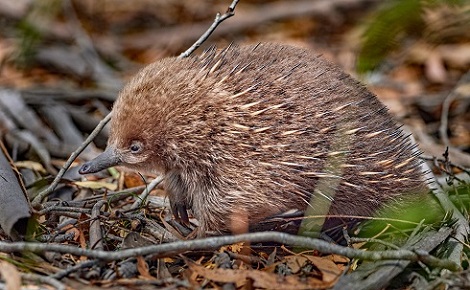
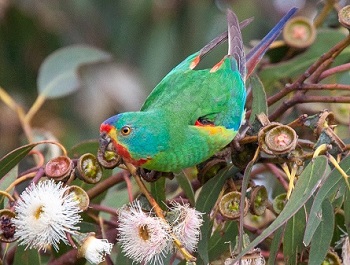 Rather than a quick visit to Tasmania, we immerse ourselves in the nature of this gorgeous island jewel. Our itinerary includes an exciting Southern Ocean pelagic, an exploration of Maria Island, the famed Bruny Island, Mount Field National Park, Cradle Mountain, Hobart, and the island’s spectacular southern coast.
Rather than a quick visit to Tasmania, we immerse ourselves in the nature of this gorgeous island jewel. Our itinerary includes an exciting Southern Ocean pelagic, an exploration of Maria Island, the famed Bruny Island, Mount Field National Park, Cradle Mountain, Hobart, and the island’s spectacular southern coast.
Join us in Tasmania - a bucket list destination, with scenery and wildlife that will take your breath away!
Contact gina@sunrisebirding.com to reserve your space!
Photos: Above, Strong-billed Honeyeaters by Craig Smith; Wedge-tailed Eagle by Alfred Schulte; Echidna by Alex Schwab; Swift Parrot by Brent Thompson.
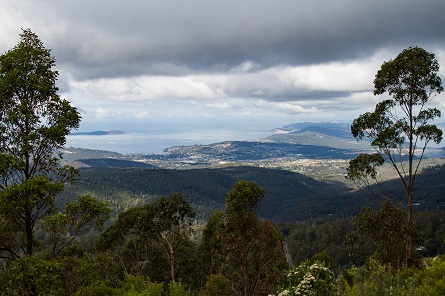 ITINERARY
ITINERARY
Day 1 /11 if arriving from Southeast Australia tour. Arrival in Hobart.
Today is the arrival day in Tasmania’s capital city, Hobart, vibrant and active port area full of fishing and sailing boasts and the beautiful heritage buildings of downtown. You will meet your guide at the hotel at 18:30 for a brief orientation and welcome dinner.
Accommodation: Hobart Hotel (en suite rooms). Meals Included: B,L,D
Photo: View from Mt Wellington Hobart by Alfred Schulte
Day 2/12. Maria Island and drive to Eaglehawk Neck.
We leave this morning to travel up the East Coast to Triabunna, where we will take the short 30-minute ferry ride across to Maria Island, an island with a rich history, a World Heritage Listed Probation Station, fossil cliffs and a great array of wildlife. On the way across to Maria Island, we shall look out for seals and dolphins. Maria is a fascinating island with a wide variety of bird and mammal species. Of the mammals, we can expect to see Forester Kangaroo, Tasmanian Pademelon, Bennett’s Wallaby, and Common Wombat. Maria Island also has an abundant bird assemblage, with 11 of the 12 Tasmanian endemics occurring here. We shall use our time to stroll slowly around the northern part of the island, with some outstanding scenery and the chance of seeing many bird species including Cape Barren Geese, Australasian Pipit and Flame Robins on the grazed grasslands and the chance of Swift Parrot, migratory Cuckoos and several species of Honeyeaters in the wooded areas. In the late afternoon, we will head back on the ferry.
Accommodation: Hotel on Tasman Peninsula (en suite rooms). Meals included: B, L, D
Day 3/13. Southern Ocean Pelagic.
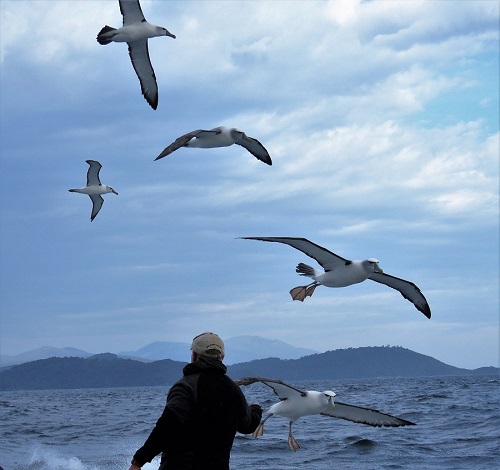 This morning, we will board a charter vessel (weather permitting), making our way into the vastness of the Southern Ocean in our quest for pelagic birds. High species diversity and the nearness of the continental shelf have earned Tasmania an international reputation as an excellent place to see pelagic species. Not long after we depart Pirate’s Bay, we will hopefully encounter Short-tailed Shearwater in considerable number. This is one of the finest places on the planet to see a diversity of albatross and Wandering, Royal, Shy, Campbell, Black-browed, and Indian Yellow-nosed Albatross are all possible. With land still in sight we will reach the continental shelf and begin to lay a berley trail from the back of the boat. Possible petrels include White-chinned, Great-winged, Grey-faced, the striking White-headed, Gould’s, Cook’s and Mottled. Shearwater diversity is also good with Hutton’s, Fluttering, Sooty and Short-tailed Shearwater all possible. Wilson’s, Grey-backed and White-faced Storm Petrels and Fairy Prion are also regularly seen. Mammals we may encounter include Australian Fur-seals, Hump- backed Whale, Common and Bottlenose Dolphin. On our return to shore there will also be a chance to visit some nearby geological formations and if time permits explore Tasman National Park before heading back to our hotel.
This morning, we will board a charter vessel (weather permitting), making our way into the vastness of the Southern Ocean in our quest for pelagic birds. High species diversity and the nearness of the continental shelf have earned Tasmania an international reputation as an excellent place to see pelagic species. Not long after we depart Pirate’s Bay, we will hopefully encounter Short-tailed Shearwater in considerable number. This is one of the finest places on the planet to see a diversity of albatross and Wandering, Royal, Shy, Campbell, Black-browed, and Indian Yellow-nosed Albatross are all possible. With land still in sight we will reach the continental shelf and begin to lay a berley trail from the back of the boat. Possible petrels include White-chinned, Great-winged, Grey-faced, the striking White-headed, Gould’s, Cook’s and Mottled. Shearwater diversity is also good with Hutton’s, Fluttering, Sooty and Short-tailed Shearwater all possible. Wilson’s, Grey-backed and White-faced Storm Petrels and Fairy Prion are also regularly seen. Mammals we may encounter include Australian Fur-seals, Hump- backed Whale, Common and Bottlenose Dolphin. On our return to shore there will also be a chance to visit some nearby geological formations and if time permits explore Tasman National Park before heading back to our hotel.
If you choose not to partake in the Pelagic cruise, you can have the day to yourself to explore the lovely beaches and forests near by the hotel, please let us know your preference when you book the tour. Accommodation: Hotel on Tasman Peninsula (en suite rooms). Meals Included: B, L, D
Photo, above: Pelagic by Gina Nichol.
Day 4/14. Tasman Peninsula to Bruny Island, including Marion’s Bay and Orielton.
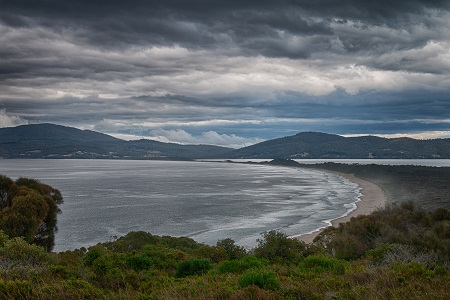 Today we have a further chance to explore the Tasman Peninsula before heading back towards Hobart, visiting some wetlands and coastal locations en route such as Marion’s Bay and Orielton Lagoon for a variety of waders and shorebirds. We will then head down to Bruny Island. Situated 40km south of Hobart, Bruny Island is separated from the Tasmanian mainland by the D’Entrecasteaux Channel and accessed by a vehicle ferry. The ferry trip takes approximately 15 minutes where one can enjoy some wonderful scenery. This afternoon we will visit Bruny’s southern coastline to view the second oldest lighthouse in Australia, and search for species such as Tawny-crowned Honeyeater, Olive Whistler and Yellow-tailed Black-cockatoo. Here we also have a chance to see the Tasmanian sub-species of Short-beaked Echidna, one of Australia’s two egg-laying mammal (monotreme) species.
Today we have a further chance to explore the Tasman Peninsula before heading back towards Hobart, visiting some wetlands and coastal locations en route such as Marion’s Bay and Orielton Lagoon for a variety of waders and shorebirds. We will then head down to Bruny Island. Situated 40km south of Hobart, Bruny Island is separated from the Tasmanian mainland by the D’Entrecasteaux Channel and accessed by a vehicle ferry. The ferry trip takes approximately 15 minutes where one can enjoy some wonderful scenery. This afternoon we will visit Bruny’s southern coastline to view the second oldest lighthouse in Australia, and search for species such as Tawny-crowned Honeyeater, Olive Whistler and Yellow-tailed Black-cockatoo. Here we also have a chance to see the Tasmanian sub-species of Short-beaked Echidna, one of Australia’s two egg-laying mammal (monotreme) species.
On one of our two nights on Bruny, depending on best weather conditions, we will visit the Short-tailed Shearwater (and occasional Little Penguin) colony to view these species at their burrows and will take an evening drive in search of Tasmania’s nocturnal marsupials. We will hope to see some species which are now restricted to Tasmania including Eastern Quoll (a relative of the Tasmanian Devil) and Tasmanian Pademelon, Bennett’s Wallaby and Brush-tailed Possum are also common here and rare golden/white color morphs of both these species can sometimes be found. If we are lucky, we may also see Long-nosed Potoroo and some nocturnal birds like Tawny Frogmouth and Tasmanian Boobook. Accommodation: Cottages South Bruny Island (en suite cabins). Meals Included: B,L,D.
Photo, above: The Neck Bruny Island by Brad Moriarty; below, Fourty-spotted Pardalote by Andrew Browne.
Day 5/15 Full day on Bruny Island.
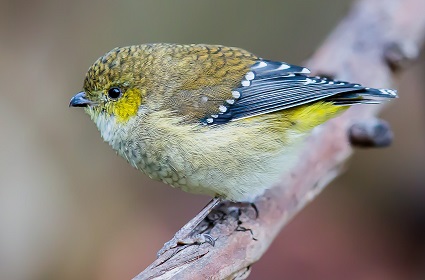 Today we have a full day to explore Bruny Island. We will start the day birding at ‘Inala’, a privately owned 1,500-acre wildlife sanctuary which is home to all 12 Tasmanian endemic bird species, including one of the largest known colonies of endangered Forty-spotted Pardalote. Strong-billed, Yellow-throated and Black-headed Honeyeaters, Dusky Robin and Green Rosella are also regulars here. Several hides and platforms have also been built around the property which provide close views of some very special species, including a variety of raptors. At this time of year, we can expect to see the endangered white color morph of Grey Goshawk, White-bellied Sea-eagle, Brown Goshawk, Brown Falcon and if we are lucky, Wedge-tailed Eagle. We will also visit a variety of habitats on the island, from coastal beaches for Hooded Plover, Pied and Sooty Oystercatcher, Pacific and Kelp Gull, to rainforest areas in search of Pink Robin and the endemic Scrubtit, Tasmanian Scrubwren and Tasmanian Thornbill.
Accommodation: Cottages South Bruny Island (en suite cabins). Meals Included: B,L,D.
Today we have a full day to explore Bruny Island. We will start the day birding at ‘Inala’, a privately owned 1,500-acre wildlife sanctuary which is home to all 12 Tasmanian endemic bird species, including one of the largest known colonies of endangered Forty-spotted Pardalote. Strong-billed, Yellow-throated and Black-headed Honeyeaters, Dusky Robin and Green Rosella are also regulars here. Several hides and platforms have also been built around the property which provide close views of some very special species, including a variety of raptors. At this time of year, we can expect to see the endangered white color morph of Grey Goshawk, White-bellied Sea-eagle, Brown Goshawk, Brown Falcon and if we are lucky, Wedge-tailed Eagle. We will also visit a variety of habitats on the island, from coastal beaches for Hooded Plover, Pied and Sooty Oystercatcher, Pacific and Kelp Gull, to rainforest areas in search of Pink Robin and the endemic Scrubtit, Tasmanian Scrubwren and Tasmanian Thornbill.
Accommodation: Cottages South Bruny Island (en suite cabins). Meals Included: B,L,D.
Day 6/16. Bruny Island to Mount Field area and Gould’s Lagoon.
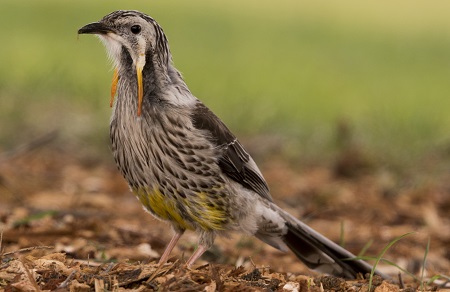 Today we depart Bruny Island and spend a bit of time exploring the reserves in the Hobart area including kunanyi (Mount Wellington). This mountain, at a height of 1,270m (around 4,150 feet), affords spectacular views of the city and surrounding landscape on a clear day. Further endemic highlights we will look for today include Green Rosella, Tasmanian Native Hen, Black Currawong, and Yellow Wattlebird. We will also visit a lagoon for the chance to see a variety of waterbirds like Australasian Shoveler, Australian Shelduck and Black-fronted Dotterel before heading to our accommodation for tonight at a national award-winning farm-stay, overlooking picturesque Lake Meadowbank, close to Mt Field National Park. Tonight, we will enjoy a hearty farm fresh barbeque dinner before settling into our cozy cottages.
Accommodation: Mount Field area (en suite rooms). Meals Included: B, L, D
Today we depart Bruny Island and spend a bit of time exploring the reserves in the Hobart area including kunanyi (Mount Wellington). This mountain, at a height of 1,270m (around 4,150 feet), affords spectacular views of the city and surrounding landscape on a clear day. Further endemic highlights we will look for today include Green Rosella, Tasmanian Native Hen, Black Currawong, and Yellow Wattlebird. We will also visit a lagoon for the chance to see a variety of waterbirds like Australasian Shoveler, Australian Shelduck and Black-fronted Dotterel before heading to our accommodation for tonight at a national award-winning farm-stay, overlooking picturesque Lake Meadowbank, close to Mt Field National Park. Tonight, we will enjoy a hearty farm fresh barbeque dinner before settling into our cozy cottages.
Accommodation: Mount Field area (en suite rooms). Meals Included: B, L, D
Photos: Above, Yellow Wattlebird by Angus McNab; below, Platypus by Cat Davidson.
Day 7/17. Mount Field and Styx Valley area.
Today we will spend the entire day exploring Mount Field National Park and surrounding areas. This area is an excellent back up site for our endemic target species, notably Scrubtit and Black Currawong, and is also a great place to experience a range of habitats from fern gullies with waterfalls, to alpine heathland and cool temperate rainforest boasting some of the tallest trees in the world - the mighty Mountain Ash (Eucalyptus regnans). Today we also have our first chance of seeing the bizarre Platypus, the other species of Australian monotreme. In the late afternoon we will return to our farm-stay for a relaxed second night.
Accommodation: Mount Field/New Norfolk area (en suite rooms). Meals Included: B, L,D.
Day 8/18. Mt Field area to Cradle Mountain National Park.
This morning, we will travel north to Cradle Mountain National Park. While today is largely a travel day, we will enjoy wonderful diverse scenery and stop many times en-route to bird and stretch our legs including at an Alpine Lake with incredible flora and landscape and the possibility of Striated Fieldwren. If time allows, we shall incorporate a visit to a beautiful location near Latrobe with an excellent chance of seeing Platypus. We will arrive at our accommodation within the Cradle Mountain National Park in the late afternoon. The accommodation provides a wonderful opportunity to view Wombats and Wallabies near your cottages. Echidnas and Platypus are also often seen in the area. Based on weather conditions, on one of our two nights staying at Cradle we shall take a night drive into the National Park after dinner, where we will hope to see Spotted-tailed Quolls, Eastern Quolls or even the iconic Tasmanian Devils.
Accommodation: Hotel Cradle Mountain (en suite rooms). Meals Included: BLD
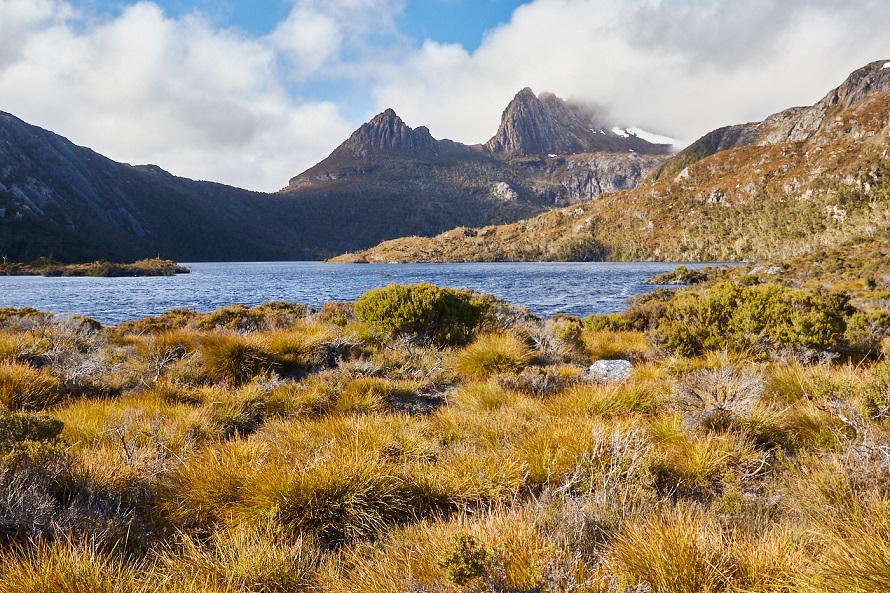
Photos: Above, Cradle Mountain Tasmania by Cindy Marple; below, Wombats by Christine Rand.
Day 9/19 Cradle Mountain area.
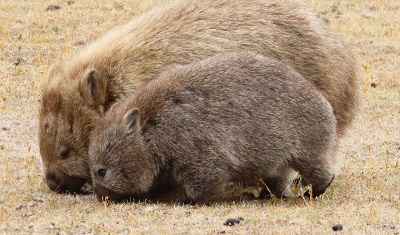 Today we have a full day to explore the spectacular landscape around Cradle Mountain. This should provide a good chance to see more of Tasmania’s endemic bird species which we may have missed previously, such as Black Currawong and Scrubtit. In addition to the great birding, we can view endemic Tasmanian rainforest flora with ancient Gondwanan connections such as Pencil and King Billy Pines, Myrtle and the famous Fagus (Nothofagus gunnii) which is Tasmania’s only deciduous tree. The National Park is also a great area to view the adorable Common Wombat. While watching for Pink Robin alongside a beautiful river, we will also have more chances of spotting Platypus. During the day we shall include a visit to Walheim, the replica hut built in the site of Gustav Weindorfer’s original home, a naturalist whose passion was instrumental in the establishment of the National Park protection of this area.
Accommodation: Hotel Cradle Mountain (en-suite rooms). Meals Included: B, L, D.
Today we have a full day to explore the spectacular landscape around Cradle Mountain. This should provide a good chance to see more of Tasmania’s endemic bird species which we may have missed previously, such as Black Currawong and Scrubtit. In addition to the great birding, we can view endemic Tasmanian rainforest flora with ancient Gondwanan connections such as Pencil and King Billy Pines, Myrtle and the famous Fagus (Nothofagus gunnii) which is Tasmania’s only deciduous tree. The National Park is also a great area to view the adorable Common Wombat. While watching for Pink Robin alongside a beautiful river, we will also have more chances of spotting Platypus. During the day we shall include a visit to Walheim, the replica hut built in the site of Gustav Weindorfer’s original home, a naturalist whose passion was instrumental in the establishment of the National Park protection of this area.
Accommodation: Hotel Cradle Mountain (en-suite rooms). Meals Included: B, L, D.
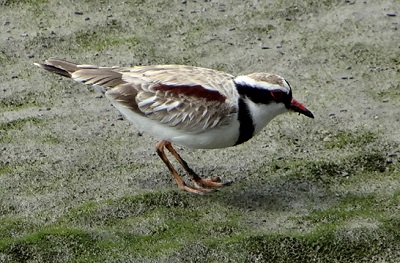 Day 10/20. Launceston and depart.
Day 10/20. Launceston and depart.
This morning, we travel to Launceston after breakfast where you will be able to connect with a flight of your choice to one of the capital cities. If time permits, we will visit some wetlands en- route where there is a chance to view several wetland species including Purple Swamphen, Spotless Crake, Australian Shelduck, Black-fronted Dotterel and Little Grassbird.
Please note flights from Launceston should be made from 1pm onward as the guide will deliver those guests to the airport around midday.
Meals Included: B.
Photo: Black-fronted Dotterel by Steve Bird.
Leaders: Steve Bird, Gina Nichol & local guides
Photos credits, top to bottom: Strong-billed Honeyeater by Craig Smith;
Wedge-tailed Eagle by Alfred Schulte;
Echidna by Alex Schute;
Swift Parrot by Brent Thompson;
View from Mt Wellington Hobart by Alfred Schulte;
Pelagic by Gina Nichol;
The Neck on Bruny Island by Brad Moriarty; Forty-spotted Pardalote by Andrew Browne;
Yellow Wattlebird by Angus McNab;
Platypus by Cat Davidson;
Cradle Mountain by Cindy Marple;
Wombat by Christine Rand;
Black-fronted Dotterel by Steve Bird;
below, Swift Parrot by Brent Thompson;
 TASMANIA TASMANIANovember 1 - 10, 2026 Contact gina@sunrisebirding.com to reserve your space! Registration Form> TOUR PRICE: US$7495.00 provisional pricing per person, based on double occupancy and a minimum of 7 persons from Hobart, Tasmania (airport code HBA). Single
supplement: US$895.00provisional per person based on availability Deposit: $1000.00
per person
per tour.
Note:
Tour deposits
can be
paid by
credit
card via
PayPal.
Use this link to
make your credit card payment. Please
advise gina@sunrisebirding.com
when you have made payment. Included in cost: All
accommodations,
meals during the tour,
and guide
services
as stated
in the
itinerary,
private
ground
transportation
during
the tour,
and park
entrance
fees. Not included: International, domestic flights, tipping for drivers and guides, travel insurance, excess baggage charges, private excursions, à la carte dishes, snacks, drinks, laundry, telephone calls and anything else of a purely personal nature. Also, any and all costs arising from pandemic or Covid-19 related issues are not included in the tour cost and are the sole responsibility of the traveler. These include, among others, the costs of Covid treatment, hospitalization, medical fees, transport, meals and accommodation in case of illness or quarantine, and the costs of any Covid tests needed before, during and after the tour.
Once
the tour is
confirmed to
go ahead, we
will send you
information
about booking
your flights.
**Please
note: Tour prices
are based on
quoted costs
from ground operators
(in their local
currency), estimated
fuel costs, and
the rate of exchange
the time of itinerary
publication.
The erratic nature
to global financial
markets makes
it difficult
to predict changes
in costs and
foreign currency
exchange rates
over the long
term. Since tours
are priced well
in advance of
the actual operation
of the tour,
tour costs, fuel
costs and exchange
rates can change,
sometimes drastically.
Depending on
the extent of
such changes,
it may be necessary
to implement
a surcharge on
this tour. If
a surcharge is
necessary, every
effort will be
made to minimize
the amount. Cancellations
and Refunds:
TRIP INSURANCE: PLEASE NOTE:
|
Phone: 203.453.6724